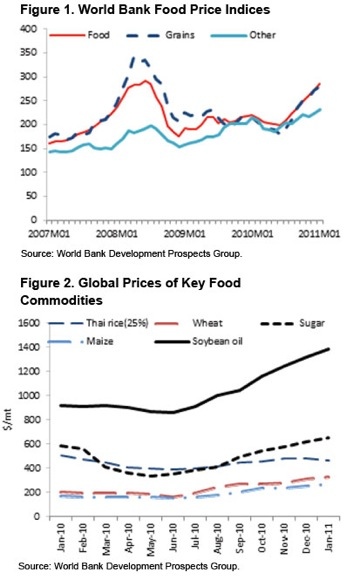
Food prices reaching dangerous levels: World Bank
By Food in Canada staff
Business Operations Food Trends World BankRecent data finds that rising food prices driving more people into poverty
Washington, D.C. – More than 44 million people fell into poverty in low- and middle-income countries since June 2010 and experts can trace that back to the rise in food prices.
That statistic comes from The World Bank, which released several figures in its latest Food Price Watch ahead of the G20 Meeting of Finance Ministers and Central Bank Governors in Paris on Feb. 18 and 19.
According to the recent statistics, the World Bank’s food price index rose by 15 per cent between October 2010 and January 2011, is 29 per cent above its level a year earlier, and is only three per cent below its 2008 peak.
Among grains, global wheat prices have risen the most, doubling between June 2010 and January 2011. Maize prices are about 73 per cent higher, but crucially for many of the world’s poor, rice prices have increased at a slower rate than other grains. Sugar and edible oils have also gone up sharply. Other food items essential for dietary diversity in many countries have increased, such as vegetables in India and China, and beans in some African countries.
According to Food Price Watch, the increase in extreme poverty (under US$1.25 a day) due to the price hike is associated with higher malnutrition, as poorer people eat less and are forced to buy food that is both less expensive and less nutritious.
In contrast to the 2008 food price spike, two factors have prevented even more people falling into poverty this time. One is that good harvests in many African countries have kept prices stable, especially for maize, a key staple. Another is the fact that the increases in global rice prices have been moderate and the outlook for the rice market appears stable.
Measures to address the recent round of food price spikes include expanding nutritional and safety net programs in countries where food prices are rising fastest, avoiding food export restrictions, and finding better information on food stocks. More investments in agriculture, the development of less food-intensive biofuels, and climate change adaptation, are also needed.
How the World Bank is helping
The World Bank’s Global Food Crisis Response Program (GFRP) is helping some 40 million people in need through US$1.5 billion in support.
To date, more than 40 low-income countries are receiving or will receive assistance through new and improved seeds, irrigation, and other farm support and food assistance for the most vulnerable people.
For the longer-term, the World Bank Group is boosting its spending on agriculture to some US$6-8 billion a year from US$4.1 billion in 2008.
Print this page
